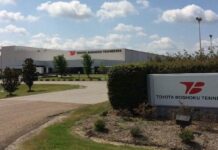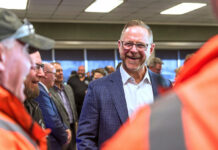
By Ed Shulman
From the March/April 2012 issue
With bailed-out industry giant GM back on top and the recovery picking up steam, industry analysts forecast 2012 global light vehicle assembly to be 83.5 million units, a 10 percent increase compared to 2011 estimates of 75.9 million units.
General Motors has claimed the number one spot in the automotive industry just two years after GM filed for bankruptcy. According to media reports, the automaker has topped sales in every corner of the globe, managing to increase profits despite years of financial struggles.
GM suffered its share of ups and downs over the past decade, but saw the worst of its struggles in 2009 when it filed for bankruptcy. In an attempt to restructure the company, GM let go of several of its top lines, including Pontiac and Saturn, in addition to selling its subprime auto loan business.
Since that time, the company slowly moved toward recovery. It has been able to repay more than half of its TARP funds received from the government, while also allowing GM to reenter the subprime business and pushing to sell shares on the New York Stock Exchange.
Now, after selling 640,000 more cars and trucks than it did in 2010 and earning more than $7 billion in profits in three quarters last year, the company pushed back to the top of the auto industry in 2011, surpassing last year’s winner, Toyota.
Toyota took the spot as the top automaker in 2010, but suffered massive losses after the tsunami in Japan devastated many of the company’s plants, impacting its ability to build cars and ship parts to other automakers around the world. Now, experts say it the largest Japanese automaker is recovering from its losses and gearing up for a strong year.
Ford is also among the competition GM faces with sales up 11 percent in the past year. With that said, auto consumers may see a rise in incentives and deals as automakers contend for the top spot.
Autofacts, PwC’s automotive forecasting service, forecasts 2012 global light vehicle assembly to be 83.5 million units, a 10 percent increase compared to 2011 estimates of 75.9 million units. Although complex macroeconomic and geopolitical issues remain, strong vehicle production in the first half of 2011 is driving assembly volumes to increase over prior estimates. Chinese and Indian markets are driving significant growth in the baseline global assembly estimates.
Japan’s auto industry is fighting back with the majority of the country’s vehicle manufacturers and suppliers expected to be back to full tilt by September. Japan’s faster than anticipated recovery has also contributed to the upward revision of the global assembly estimates.
The country has been rebuilding its industry over the summer months and is now on course for an output of 8.4 million units for 2011—some 221,000 more than had been previously expected. Autofacts also predicts that globally, total light vehicle assembly will be 75.9 million units in 2011, nearly a 6 percent increase from 2010 levels.
“While economic uncertainty continues, light vehicle production thus far is demonstrating resilience with stronger than expected growth,” said Calum MacRae, PwC’s lead automotive analyst, Autofacts. “Perhaps the most significant element to the third quarter forecast is the faster than expected recovery of the Japanese automotive value chain, with most manufacturers expecting full capacity to be restored by September.”
Inflationary fears and registration quotas have contributed to a slowdown in vehicle sales growth in China. In response, the Chinese government has announced new incentives, which could boost demand in the second half of the year from the 5.8 percent recorded in the first half. Europe’s sales environment remains weak to mixed across primary markets, but production is being supported by strong export growth to China, Russia, Turkey and the US.
China’s coastal cities are coping with severe traffic congestion and Beijing, by example, has limited new car registrations to only 240,000 in 2011. Automotive sales in India have also moderated. As of June 2011, the Indian market has reported 16 percent annual growth compared with 34 percent in 2010.
Sluggish economic growth, weak consumer spending and Japanese inventory shortages have caused a mid-year sales slump in the US market. While North America’s automotive supply chain continues to address capacity constraints it is still on course for a 2011 production forecast of nearly 13 million units, a roughly 1 million unit increase from 2010.
Perry County: Bringing the Right Components
Finding balance is often a never-ending quest that consumes lifetimes. For the lucky few, that quest is realized when the right components are brought together to achieve the desired goal.
The balance that has been achieved in Perry County, IN, was forged by dedicated visionaries who committed their efforts to bringing together key partnerships for the ultimate goal of balancing the abundant natural resources with a progressive business climate. The end result is the ability to execute successful, world-class business operations in an atmosphere that lends itself to breathtaking views, outdoor adventures and tranquility. For outside observers, an afternoon cruise through the tree-lined hills and valleys can occasionally result in a glimpse of a high-tech production facility that is in the midst of competing on a global scale.
“There were a multitude of locations that would have worked along the river,” commented Bruce Tesch, Plant Manager of ThyssenKrupp Waupaca, an iron foundry. “This community just jumped forward and provided everything that ThyssenKrupp was requiring.”
Some of this rural county’s business successes are directly related to its location. Sitting in the heart of the United States near the geographic center of North America and the median center of the US population, Perry County sits on the banks of the Ohio River, the nation’s busiest waterway. The county’s proximity to two commercial airports, coupled with interstate access, port facilities and railroad services make it ideally situated to meet the transportation needs of any commodity-based business.
As the epi-center for gray and ductile iron products, much of Perry County’s productivity focuses on automotive and heavy construction components and component parts. ThyssenKrupp Waupaca’s Plant 5 operation features the largest vertical molding machine in the world to aid with production of parts for end-users including Toyota, Ford, Caterpillar, Chrysler and Cummins. Webb Wheel Products (an OEM producer of components for the heavy truck industry) and ATTC Manufacturing (a supplier of more than 80 component parts to Toyota for use in 10 different vehicles) both utilize advanced robotic machining equipment in their processes.
This advance manufacturing environment helps these companies to produce the next generation of products faster, cheaper and cleaner. As manufacturing changes with newly adopted methods of production, the Perry County business community promotes the advancement of new, technologically enhanced methods of production. In addition, employees are encouraged to offer their input into processes and career enhancement, both of which further improve the company’s competitive advantage.
Those businesses that have chosen to come and stay in Perry County have done so to take advantage of the array of economic opportunities balanced with attractive living options available for employees and their families. At the end of their work-day, employees of these companies have the opportunity to participate in an assortment of activities including family–oriented events, outdoor-recreation in the Hoosier National Forest, and water sports on the Ohio River.
Companies in Perry County have had the opportunity to benefit from the strong partnerships that were established years ago by those visionaries. The community’s commitment to working with companies to help to insure each business remains competitive in a global economy manifests itself on the first day of contact.
“Perry County really rose to the top from the standpoint of the assistance they gave to making it come together and the real strong pro-active nature they took and the clear interest in having the business,” noted Kent Finkbiner, President of Webb Wheel Products who located in the County in 2004.
Most recently the Perry County Development Corporation, the county’s lead economic development agency, addressed a warehouse need of a local business. The corporation identified an older building in the downtown Tell City area and rehabilitated the building with the end result being a 52,000 square foot warehouse with three loading docks. The business now has improved efficiencies and closer scrutiny of its inventory.
With a population of nearly 20,000 people, Perry County offers the charm of a smaller, rural community combined with the progressive corporate attitude and sophisticated infrastructure usually found in larger metropolitan areas. Leadership in Perry County proactively works to grow the regional economy through business attraction, retention and expansion; through encouraging and supporting entrepreneurs; and through providing government and workforce advocacy. All of this is done with the ultimate goal of positively impacting each business’ bottom line expenses while maximizing employee income and overall quality of life.
To further explore the benefits of conducting business in Perry County the Perry County Development Corporation has posted company testimonials online.
Harrison County: Epicenter of Supplier Network
Given the strong presence of Ford Motor Company in Louisville, KY, Harrison County is an ideal location for suppliers to the automotive industry. Recently, ICON Metal Forming, a metal stamping company in Corydon began hiring to make parts they will produce for the new Ford Escape that will be made at the Louisville Assembly Plant about 35 miles away in Louisville. ICON presently employs 300 workers. The Economic Development Corporation and the County Government have assisted ICON with expansion projects in the past by supplying incentives to train workers and reduce the company’s property taxes.
The incentive programs offered by the ED Corporation are quite flexible and can be customized to meet the individual needs of the manufacturers. Assisting companies in the automotive industry gives the community an opportunity to “upskill” our labor force, as was described in Business Facilities’ Economic Development Deal of the Year cover story in our Jan/Feb issue, which named Kentucky’s automotive partnership with Ford Motor Company the Gold Award winner.
This rural community has outstanding highway access on I-64 just 25 miles west of Louisville’s city center. Recent investment in infrastructure projects has allowed Harrison County to expand the sewer and water capacities available and has brought improved roadways to better accommodate business development. The Economic Development Corporation is marketing a Business Park that is owned by the Chamber of Commerce and is certified Shovel Ready by the State of Indiana. The Harrison Rural Electric Cooperative supplies electricity to the industrial area and provides outstanding dependability with two substations within a mile of the Business Park. Sites have been considered by several suppliers to Toyota Motor Corporation, which has assembly plants 90 miles west in Princeton, IN and 90 miles east in Georgetown, KY.
The property has attracted Howard Packaging; a California based plastic injection molding company that makes bottles for Lucas Oil Products, which established a production facility and distribution center in Corydon in 2002. Lucas Oil has grown considerably since locating here and produces about 80% of its world-wide oil and fuel additives at the Corydon facility. The Business Park still has 60 acres remaining that is Shovel Ready and nearby parcels can also be developed for additional expansion.
Because of its ideal location Harrison County has been one of the fastest growing counties in Indiana over the past 30 years. The aggressive approach to creating jobs has helped to improve the overall standard of living for the existing residents, has kept property tax rates among the lowest in the state and the population of the county continues to grow even during challenging economic times.















![[VIDEO] Get More for Your Business in Ardmore. Oklahoma](https://businessfacilities.com/wp-content/uploads/2024/02/maxresdefault-324x160.jpg)
